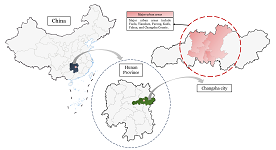
Asia Pacific Academy of Science Pte. Ltd. (APACSCI) specializes in international journal publishing. APACSCI adopts the open access publishing model and provides an important communication bridge for academic groups whose interest fields include engineering, technology, medicine, computer, mathematics, agriculture and forestry, and environment.

As China's pillar industry, the property market has suffered a considerable impact in recent years, with a decline in turnover and many developers at risk of bankruptcy. As one of the most concerned factors for stakeholders, housing prices need to be predicted more objectively and accurately to minimize decision-making errors by developers and consumers. Many prediction models in recent years have been unfriendly to consumers due to technical difficulties, high data demand, and varying factors affecting house prices in different regions. A uniform model across the country cannot capture local differences accurately, so this study compares and analyses the fitting effects of multiple machine learning models using February 2024 new building data in Changsha as an example, aiming to provide consumers with a simple and practical reference for prediction methods. The modeling exploration applies several regression techniques based on machine learning algorithms, such as Stepwise regression, Robust regression, Lasso regression, Ridge regression, Ordinary Least Squares (OLS) regression, Extreme Gradient Boosted regression (XGBoost), and Random Forest (RF) regression. These algorithms are used to construct forecasting models, and the best-performing model is selected by conducting a comparative analysis of the forecasting errors obtained between these models. The research found that machine learning is a practical approach to property price prediction, with least squares regression and Lasso regression providing relatively more convincing results.
URBAN service diversity and labor mobility—Analysis Based on "meituan.com" big data and micro survey of floating population
Vol 3, Issue 1, 2022
Download PDF
Abstract
In the context of the new era, people's pursuit of a better life is becoming more and more prominent. The diversity and welfare of urban services will become an important support for attracting labor and optimizing talent structure. This paper uses the "meituan.com" life service classification and the 2017 China floating population dynamic monitoring survey (CMDS) data to study the impact of urban service diversity on labor mobility. The results show that the diversity of urban services will significantly reduce the willingness of migrant population to move out. For every 1% increase in the diversity of service categories, the average probability of labor migration will be reduced by about 3.5% 23%; The impact of urban service diversity has group differences. Younger and highly skilled groups are more sensitive, and the marginal effect can reach 4.5% 62% and 4 03%. Considering the adjustment effect and regional heterogeneity, the expansion analysis further found that the level of urban informatization and marketization has a positive amplification effect on the diversity of service categories to attract and retain talents, especially in the eastern region and large cities with a population of more than 5 million. This study provides policy enlightenment for urban talent attraction and labor competition.
Keywords
References
- Zhang L, He J, Ma R. How do house prices affect labor mobility, Economic research. Economic Research; 2017. pp. 155– 170.
- Liang W. If you don't live well, you don't consume: Why is the exclusion of foreign population not conducive to increasing the income of local population. Managing the world; 2018. pp. 78–87, 191–192.
- Dahlberg M, Eklöf M, Fredriksson P, et al. Estimating Preferences for Local Public Services Using Migration Data. Urban Studies. 2011; 49(2): 319–336. doi: 10.1177/0042098011400769
- Song H, Wu M. Does high house prices lead to the outflow of regional high skilled human capital? Financial research ; 2020. pp. 77–95.
- Massey DS. Social Structure, Household Strategies, and the Cumulative Causation of Migration. Population Index. 1990; 56(1): 3. doi: 10.2307/3644186
- Diamond R. The Determinants and Welfare Implications of US Workers’ Diverging Location Choices by Skill: 1980 –2000. American Economic Review. 2016; 106(3): 479–524. doi: 10.1257/aer.20131706
- Lu M, Gao H, Sato H. Urban scale and inclusive employment. China Social Sciences; 2012. pp. 47–66, 206.
- Roca JDL, Puga D. Learning by Working in Big Cities. The Review of Economic Studies. 2016; 84(1): 106 –142. doi: 10.1093/restud/rdw031
- Lee S. Ability sorting and consumer city. Journal of Urban Economics. 2010; 68(1): 20 –33. doi: 10.1016/j.jue.2010.03.002
- Glaeser EL, Kolko J, Saiz A. Consumer city. Journal of Economic Geography. 2001; 1(1): 27 –50. doi: 10.1093/jeg/1.1.27
- Melo PC, Graham DJ, Noland RB. A meta-analysis of estimates of urban agglomeration economies. Regional Science and Urban Economics. 2009; 39(3): 332–342. doi: 10.1016/j.regsciurbeco.2008.12.002
- Sun W, Zhang X, Zheng S. Air pollution and spatial mobility of labor force -- a study based on the employment location behavior of floating population. economic research; 2019. pp. 102–117.
- Zhang H, Lin X, Liang R, LAN J. Urban ecological civilization construction and new generation labor power flow -- a new perspective of labor resource competition. China industrial economy; 2019. pp. 81–97.
- Ma S and Zhao W. Dialect diversity and income of floating population -- An Empirical Study Based on chfs. Economics (quarterly); 2019. pp. 393–414.
- Lu Y and Zhang K. Geographical distance, dialect culture and spatial mobility of labor force. Statistical research; 2019. pp. 88–99.
- Zhang J, Huang J, Wang J and Huang J. Urban settlement threshold and labor return. Economic research; 2020. pp. 175–190.
Supporting Agencies
Copyright (c) 2022 Wenwu Zhang, Yongze Yu

This work is licensed under a Creative Commons Attribution 4.0 International License.

This site is licensed under a Creative Commons Attribution 4.0 International License (CC BY 4.0).

Prof. Mehmet Cetin
Kastamonu University,
Turkey
Polish Scientific Bibliography

